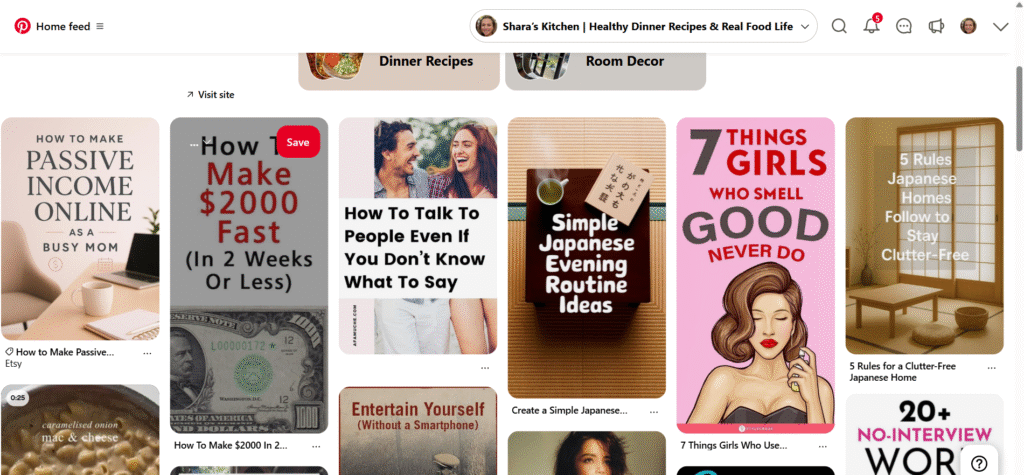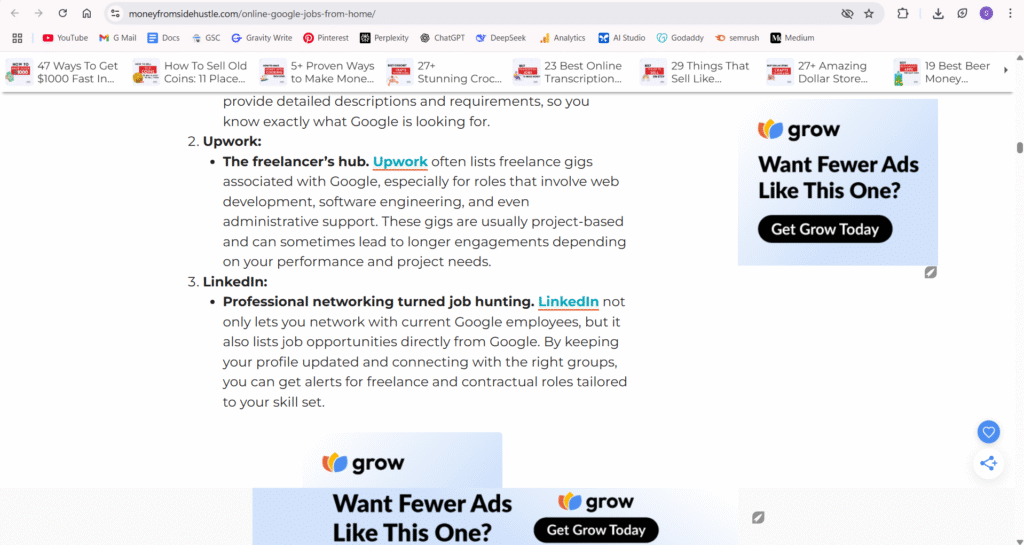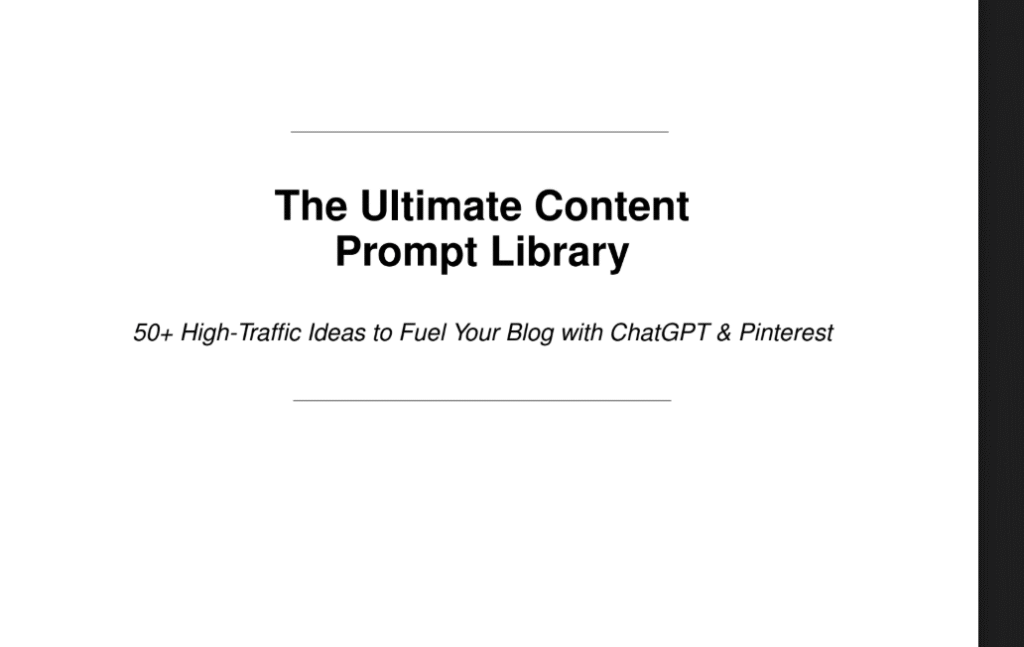When people talk about making money online, the first things they usually mention are SEO, Google search rankings, or growing a big audience.
But I didn’t do any of that.

I made my first $50 online using just three tools:
- ChatGPT
- A simple blog with ads
No keyword research.
No Google search traffic.
No email list.
No paid promotions.
In this post, I’ll show you exactly how I did it — step-by-step — so that you can follow the same system, even if you’re starting from scratch with no audience.
Step 1: Understanding the Strategy Before Starting
Before we dive into tools and tactics, you need to understand how this system works at its core.
The goal is not to sell anything upfront.
The goal is to drive targeted traffic from Pinterest to your blog post and earn money through display ads on that blog post.
Here’s the simple breakdown of how the system works:
- Create helpful content using ChatGPT
- Post it on your blog (ideally monetized with ads)
- Use Pinterest to drive traffic to that blog
- Every visit = ad revenue (even if the user doesn’t buy anything)
This system earns money in two ways:
- Ad revenue from blog traffic
- Optional: Upselling a digital product (journal, planner, PDF, etc.)
Let’s break it down step by step.


Step 2: Choose a Beginner-Friendly Topic with Traffic Potential
The first thing you need to decide is what content you want to create.
You don’t need to overthink this. Pinterest works well for content in the following categories:
- Self-improvement
- Wellness and mental health
- Journaling and printables
- Productivity and time management
- Online side hustles
- Digital products and blogging tips
In my case, I chose to write about self-love journal prompts because:
- It’s evergreen content (people search for this year-round)
- It’s beginner-friendly
- It’s highly shareable on Pinterest
Your goal is to pick a topic that solves a small problem for someone or gives them value instantly.
Step 3: Use ChatGPT to Write the Blog Post
Once you know your topic, use ChatGPT to help you write the blog content faster.
Here’s the exact prompt I used:
Prompt:
Write a blog post titled “30 Days of Self-Love Journal Prompts” with a short introduction, benefits of journaling, and 30 unique self-reflection prompts. Keep it simple and Pinterest-friendly.
The output was clean, organized, and ready to edit.
Important: Never copy-paste the raw output. I always edit the tone to sound like myself, add a personal note or anecdote, and structure it with short paragraphs and subheadings.
I then added a few paragraphs before and after the prompt list, explained how journaling helped me personally, and formatted it inside my blog post.
Tools I used:
- ChatGPT (for writing)
- WordPress (for blogging)
- A simple blog theme with ad space
Step 4: Create Your Pinterest Pins
Pinterest is a visual search engine. To get traffic from it, you need scroll-stopping pins.
I created my pins using Canva. You can do this for free.
Steps I followed:
- Open Canva > Choose “Pinterest Pin” size (1000×1500 px)
- Choose a clean template (nothing overly designed)
- Added bold title text:
- 30 Days of Self-Love Journal Prompts
- Free PDF: Boost Your Confidence with Daily Prompts
- Save This Journal Challenge
- Added a background image (from Canva free photos) or a plain color
- Linked each pin to the blog post
You don’t need to be a designer. Use clean fonts and clear language. The goal is to tell the user exactly what value they’ll get if they click.
I created three pins for the same blog post to test different angles.
Step 5: Publish Pins and Add SEO Descriptions (Within Pinterest)
Here’s how I published the pins:
- Go to Pinterest and create a new pin
- Upload your design
- Write a title (Pinterest users will see this first)
- Add a short description using keywords
- Example: “Free 30-day self-love journaling prompts for mental wellness, confidence, and healing. Great for beginners.”
- Add the blog URL as the destination link
- Choose a relevant board (like “Self-Care” or “Journaling”)
- Publish
That’s it. Once the pin is live, it starts getting impressions and clicks based on Pinterest’s algorithm.
You don’t need to have followers. Pinterest cares more about the quality and relevance of your content than your account size.
Step 6: Add Display Ads to Your Blog
If your blog doesn’t have ads yet, you’re missing the most passive way to earn online.
I started with Google AdSense, which accepts small blogs. Later I switched to Ezoic (they pay better and accept sites with low traffic if you apply through their access program).
Here’s how display ads work:
- Every time someone visits your blog and sees an ad, you earn a small amount
- You’re paid based on RPM (revenue per 1000 views). Even $3–$5 RPM is decent for beginners
- You don’t need to sell anything — just create content people want to click from Pinterest
For example:
If I get 500 views from Pinterest in a month, and my RPM is $4.50, that’s $2.25 per day = ~$67.50 per month
This is exactly how I made my first $50.28 — through Pinterest traffic + blog ads only
Step 7 (Optional): Offer a Simple Digital Product Upsell
Once I saw traffic coming in and people spending time on the blog post, I decided to offer an optional paid version of the journal prompts.
I took the same content and expanded it into a “90-Day Self-Love Workbook” in PDF format using Canva.
I priced it at $5 and hosted it on Gumroad.
In the blog post, I added a section:
“Want to continue your journaling journey? Download the full 90-day version with bonus pages for just $5.”
A few visitors clicked. A few purchased. This gave me an extra $10–15 that month, in addition to the ad revenue.
The digital product wasn’t necessary to hit $50 — but it helped boost it faster.
What Worked and Why
This method worked for a few key reasons:
- No dependence on SEO or Google: Pinterest sends direct traffic without waiting 6 months for rankings
- Content-first approach: People came for value, not hype
- Ad-based monetization: I didn’t need people to buy to make money
- Evergreen content: Journal prompts are always relevant
- ChatGPT saved me hours of writing and idea generation
- Pinterest acted as my search engine
You Can Do This Too — Even If You’re Just Starting
If you don’t have a blog yet, that’s your first step. You can use WordPress + free themes or Blogger for starters. Then:
- Pick a topic people want
- Write your content with ChatGPT and human edits
- Publish it on your blog
- Create 2–3 Pinterest pins
- Add display ads
- Share and be consistent
This is not a “get-rich-quick” system. But it’s real, it’s simple, and it doesn’t depend on algorithms or Google rankings.
I made $50 in about three weeks this way. Now I’m repeating the process with more blog posts, more pins, and eventually more products.
Want My Toolkit?

I’ve put together everything I used into a free starter kit:
- My ChatGPT prompt structure
- Canva pin templates
- Sample self-love PDF
- Blog post layout format
You can download it here: 50+ High-Traffic Ideas to Fuel Your Blog with ChatGPT & Pinterest
This is the same toolkit I used to launch my first traffic-generating post — no fluff, just tools.




